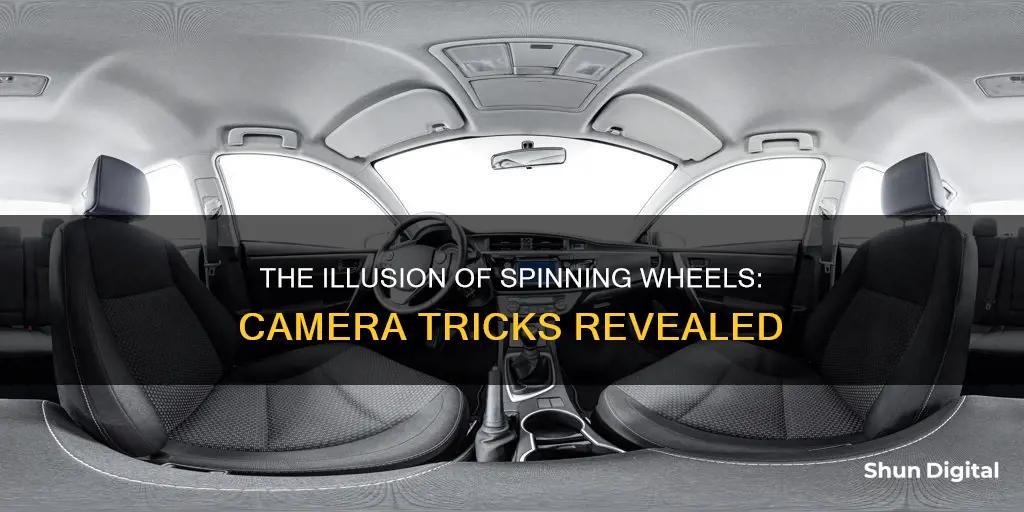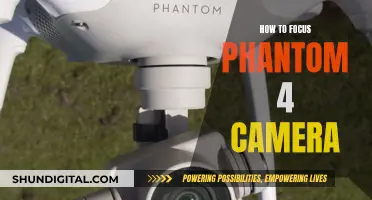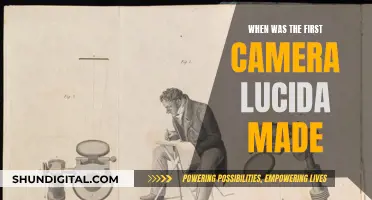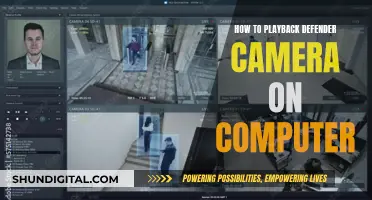
Have you ever noticed how a car's wheels sometimes appear to spin backwards on camera, even though the car is moving forwards? This strange phenomenon is known as the 'wagon wheel effect', an optical illusion that has puzzled many. The effect is caused by the way our brains process images, filling in the gaps between frames of footage with an illusion of continuous movement. If a wheel rotates most of the way between one frame and the next, our brains interpret this as backwards motion, as this suggests the smallest difference between the two frames.
| Characteristics | Values |
|---|---|
| Name of the phenomenon | Wagon-wheel effect |
| Other names | Stagecoach-wheel effect |
| Type | Optical illusion |
| Cause | The way the human brain interprets and processes images |
| Frame rate of the human eye | 200 frames per second (FPS) |
| Frame rate of the human eye for detecting motion | 13 FPS |
| Frame rate of movie cameras | 24 FPS |
| Frame rate of digital movie cameras | 25 FPS |
| Frame rate of analog movie cameras | 29.97 FPS |
| Frame rate of standard television | 59.94 or 50 images per second |
| Frame rate of modern smartphones | 120 or 240 FPS |
What You'll Learn
- The 'wagon wheel effect' is an optical illusion
- The human eye can process light at over 200 frames per second
- Cameras capture images at a finite rate, usually 24 frames per second
- The brain fills in the gaps between images, creating an illusion of continuous movement
- The brain's processing speed can be tricked, making a wheel appear to spin backwards

The 'wagon wheel effect' is an optical illusion
The wagon wheel effect is an optical illusion. It is a phenomenon in which a spoked wheel, such as those on a car, helicopter, or wagon, appears to rotate differently from its true rotation. This effect is often seen in films and television shows, particularly in Western movies, where the wheels of stagecoaches or wagons seem to spin backward or much slower than they should, given the speed of the vehicle.
The wagon wheel effect is caused by the interaction of the rotational speed of the wheel and the frame rate of the recording camera. Cameras capture images at a certain frame rate, typically 24 to 50 frames per second for movies and 25 or 30 frames per second for digital cameras. When the wheel rotates at a speed that aligns with the camera's frame rate or an integer multiple of it, the wheel appears to be stationary or rotating backward. This occurs because the wheel completes a full rotation or a multiple of a full rotation within the time interval between two consecutive frames, tricking the brain into perceiving backward or no motion.
The human eye and brain also play a role in this illusion. While the human eye can process light at frame rates upwards of 200 FPS, it detects motion at a much lower rate of up to only 13 FPS. The brain fills in the gaps between these images, creating an illusion of continuous movement. This results in the perception of backward or slow motion when the wheel's rotation aligns with the brain's processing rate.
The wagon wheel effect is not limited to recordings and can also be observed in real life. It is a result of temporal aliasing, where the visibility of a rotating wheel is broken into brief episodes of motion interrupted by longer episodes of invisibility. This effect can be observed under stroboscopic lighting conditions, where the flickering light creates the illusion of backward or slow motion.
The wagon wheel effect has been studied by neuroscientists to understand how the brain perceives and interprets visual information. It is a fascinating example of the limitations of human perception and the complex ways in which the brain constructs our visual reality.
Speeding Ticket Arrival: Mobile Camera Edition
You may want to see also

The human eye can process light at over 200 frames per second
The wagon wheel effect is an optical illusion that occurs when the rotational speed of an object and the frame rate of a camera interact in a certain way. This effect can be seen in videos or films, where the camera captures a series of still images that are then played back quickly to create the illusion of continuous movement. The human brain perceives this as a continuous stream of information, filling in the gaps between the frames to create the illusion of smooth, continuous motion.
In the case of a car wheel, if the wheel is turning at a certain speed that aligns with the camera's frame rate, the wheel will appear to be stationary or even rotating in the reverse direction. This is because the wheel's spokes will appear to be in the same or similar positions in consecutive frames, tricking the brain into perceiving backward or no motion.
While the human eye can process light at a high frame rate, our ability to detect motion is limited. This discrepancy between light processing and motion detection is what leads to the wagon wheel effect, a fascinating example of how our visual system can sometimes deceive us.
Viewing Raw Images: Overcoming Camera Crop Issues
You may want to see also

Cameras capture images at a finite rate, usually 24 frames per second
The "wagon-wheel" effect is an optical illusion that makes a wheel seem to spin backward. This phenomenon is often observed in movies, where it is caused by the finite rate at which movie cameras capture images—usually 24 frames per second.
In movies, a wheel spinning onscreen may appear to rotate slowly in the wrong direction. This is because movie cameras capture a series of still images of a scene, and the brain fills in the gaps between these images by creating the illusion of continuous motion. If a wheel rotates most of the way around between one frame and the next, the most obvious direction of motion for the brain to perceive is backward, as this direction suggests the minimal difference between the two frames.
The wagon-wheel effect is not limited to films and can also be observed in real life, even under continuous light. This cannot be explained by stroboscopic or filmic factors, and scientists have proposed two theories to explain this phenomenon. The first theory suggests that the visual cortex processes perceptual input in temporal packets, similar to how a movie camera operates. The brain may process these still images in a similar way to movie frames, and the perceptual mistake results from a limited frame rate. However, it is unclear if this is sufficient to explain the wagon-wheel effect in continuous light.
The second theory, perceptual rivalry, suggests that the brain creates two different interpretations to explain an ambiguous scene. This theory is supported by an experiment where two identical, adjacent spinning wheels were reported to switch direction independently of each other. According to the movie-camera theory, the two wheels should behave identically due to the same frame rate. However, the perceptual rivalry theory explains this discrepancy by suggesting that the brain creates two competing interpretations, with the dominant perception becoming our reality.
The Evolution of Nord Cameras: A Historical Perspective
You may want to see also

The brain fills in the gaps between images, creating an illusion of continuous movement
The "wagon-wheel" effect is an optical illusion that occurs when a spoked wheel, such as a car wheel, appears to rotate in the opposite direction from its actual rotation. This phenomenon is often observed in films and on television, but it can also be seen in real life. The illusion arises because of the way our brains process images.
The human brain fills in the gaps between images, creating an illusion of continuous movement. This is particularly noticeable when observing a wheel rotating at high speed. Our brains receive a series of images, or "frames," and interpret them as continuous motion. However, if a wheel rotates most of the way along one frame to the next, the most apparent direction of motion for the brain to comprehend is backwards. This is why a car's wheel sometimes appears to spin backwards when it is actually moving forward.
The wagon-wheel effect is not limited to wheels; it can also be observed with helicopter rotors, aircraft propellers, and other regularly spoked rotating objects. In films and on television, the effect is created by the camera's frame rate, which is typically around 24 to 50 frames per second. If a wheel completes a full rotation within one frame, it will appear stationary. If it rotates slightly less than a full rotation, it will appear to move forward. And if it rotates slightly more than a full rotation, it will seem to turn backward.
The wagon-wheel effect can also be observed in real life, even under continuous light. Scientists have proposed two main theories to explain this phenomenon. The first theory suggests that the visual cortex processes perceptual input in temporal packets, similar to how a movie camera operates. It assumes that our brains process still images in the same way as movie frames, and the illusion arises due to a limited frame rate. The second theory, known as the perceptual rivalry theory, suggests that the brain creates two different interpretations of an ambiguous scene, and these interpretations compete for dominance in our perception.
Charging Your Sanyo E1090: Quick and Easy Guide
You may want to see also

The brain's processing speed can be tricked, making a wheel appear to spin backwards
The brain processes images in a unique way, and this can sometimes lead to optical illusions, such as the "wagon wheel effect", where a wheel appears to be spinning backwards. This effect is often seen on film or television, but it can also be observed in real life.
The human eye is an incredibly powerful organ, capable of processing light at rates upwards of 200 frames per second (FPS). However, when it comes to detecting motion, the human visual system has its limitations. Studies have shown that our visual system can only detect changes in motion, like a wheel spinning, at a rate of up to 13 FPS. While our eyes can detect higher frame rates, the brain typically computes and reacts to only 10-15 images per second. This difference in processing speed can create an illusion of continuous movement between similar images, which is what leads to the wagon wheel effect.
Imagine a wheel with four spokes, each at 90 degrees to each other. If the wheel moves forward so that one spoke moves from the 12 o'clock position to the 2 o'clock position by the time the next frame is processed by the brain, it will appear to move forward as expected. However, if the wheel turns quickly enough that the spoke reaches a 90-degree interval (3, 6, 9, or 12 o'clock) by the time the next frame is processed, the brain will interpret the wheel as stationary since the spokes appear to be in their original positions.
If the wheel reaches a speed where the 12 o'clock spoke has rotated to the 11 o'clock position by the time the next frame is processed, the brain will fill in the gaps and interpret the wheel as rotating backwards. This interpretation occurs because the brain perceives a smooth backward motion as it pieces the images together. So, the illusion of backward rotation is due to the brain's limited processing speed.
The wagon wheel effect can also be observed in real life, and it is not just limited to car wheels. Helicopter rotors, aircraft propellers, and even vinyl record turntables can exhibit this phenomenon. When illuminated by flickering light or under stroboscopic conditions, the wagon wheel effect becomes more pronounced. This effect is not just an optical illusion; it has practical implications as well. For example, it can make rotating machines like lathes appear to be stopped or moving slowly, creating a safety hazard for operators.
Fine-Tuning Your Axis M3037: Focus Adjustment Techniques
You may want to see also
Frequently asked questions
The wagon wheel effect is an optical illusion that is caused by the way the brain processes images. The brain fills in the gaps between images by creating an illusion of continuous movement between similar images. If the wheel rotates most of the way along one frame to the next, the most apparent direction of motion for the brain to comprehend is backwards.
No, the wagon wheel effect can also be observed in real life. It is not limited to stroboscopic or filmic factors.
The wagon wheel effect is caused by the rotational speed of a spinning object and the camera's frame rate. For example, if a camera records at 30 frames per second and a wheel is spinning at exactly 30 revolutions per second, the wheel will be in the same position for each frame of the video, so it will look like the wheel is not spinning at all.
There are two theories. The first proposes that the visual cortex processes perceptual input in temporal packets, taking a series of snapshots and then creating a continuous scene. The second theory is perceptual rivalry, which occurs when the brain creates two different interpretations to explain an ambiguous scene.







